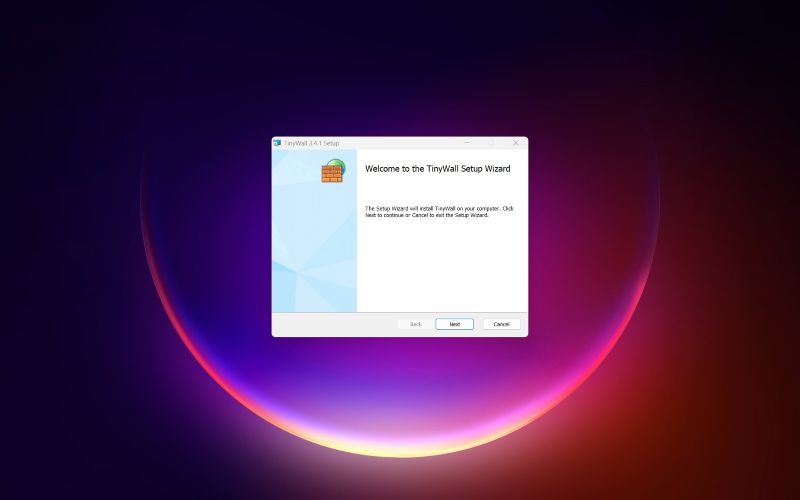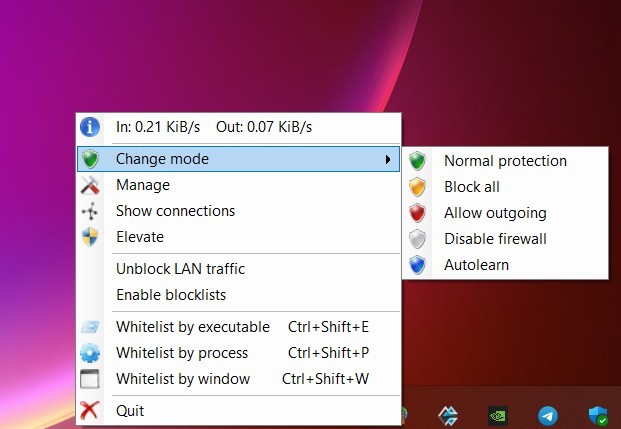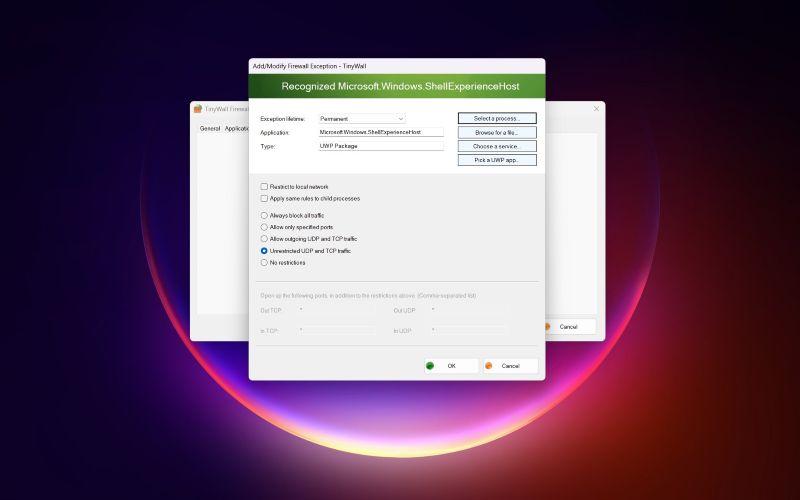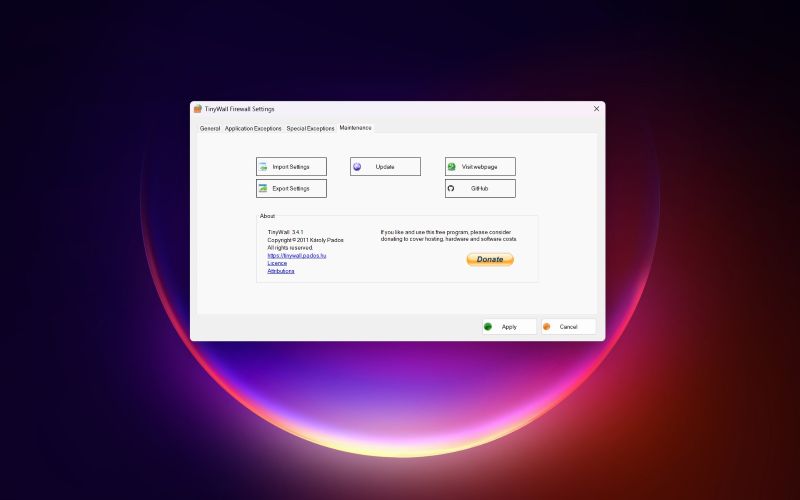Why you can trust TechRadar
We spend hours testing every product or service we review, so you can be sure you’re buying the best. Find out more about how we test.
Windows has had its own firewall, which is now known as part of the built-in Windows Security offering, since Windows XP, but while early versions were a bit wonky, it’s actually been very good since the days of Windows Vista. Unfortunately, it’s not very easy to configure, and some malware knows how to turn it off altogether.
This is where TinyWall comes in. The brainchild of Hungarian developer and computer scientist Károly Pados, TinyWall is designed to address those shortcomings and many others. It starts off with a much more secure default configuration, and gives the firewall a sane, albeit slightly obsolete-looking user interface that makes it easier to decide what to allow and what to block.
On top of that, TinyWall introduces a rather straightforward way of adding new apps to the approved list without blasting you with pop-ups all the time – although it blocks everything by default. It also makes sure unknown apps can’t simply creep into your system, turn off the firewall, and start doing bad things to your PC.
As Pados says, the Windows firewall “possesses almost everything a man” – or woman – “could ask from a firewall engine.” What TinyWall offers is a better way to use that engine and access all of its power. If you want a simple but effective and powerful firewall for Windows versions from Vista onwards, this one does a decent job, though with a dash of overprotectiveness.
That said, TinyWall’s best feature is perhaps the fact that it’s 100% free of charge, and there aren’t any ads, artificial limitations, or upgrade limitations that other free-to-download security apps might impose instead of outright demanding payment. According to the website it also doesn’t collect any user data or telemetry behind your back, so you can rest easy knowing your sensitive information is for your eyes only.
Notably, it only checks for updates once in a while automatically, during which time the current version of TinyWall running on your computer is delivered. This automatic option is on by default, but you can choose to opt out of automatic updates in the app’s settings (right-click on the TinyWall icon on the right-hand side of your taskbar).
It is also open-source, and anyone interested in its code and other details can access the source repository on the platform’s GitHub page.
Nonetheless, if you’re really happy with the app and insist on paying at least something, there’s a Donate button in its settings, where you can choose to pay whatever amount of money you wish to cover the hosting, hardware, and software costs of running the software – through the developer’s Patreon account.
Furthermore, TinyWall was designed with single private users, small-office, home-office computers, and family PCs in mind, and Pados points out that it can’t really cope with headless machines, servers, and networks with more than five computers as it lacks support for a command-line interface, remote management, and domain-controller integration.

Setup
Installing TinyWall on your device is as simple as it gets. Just head over to its official website, download the installer (its latest version as of the time of writing was released on April 6, 2025), and run it from your PC. The app has no drivers or kernel components installed, which keeps your system stable and clutter-free.
However, if you aren’t able to access the internet after the installation, there’s a reason for it. TinyWall has just blocked everything on your device from accessing the World Wide Web, and you’ll have to unblock it manually, app by app, process by process, until you get to what you need.
This isn’t particularly user-friendly, especially for a beginner who isn’t well-versed in the ways of firewalls of this kind. Nonetheless, we managed to unblock our WiFi and could continue using TinyWall as intended. This mechanism also had a positive side in making us feel super-protected, so there’s that.
According to Pados, the latest TinyWall release – 3.4.1 – has introduced some changes, including a quicker way to open the Connections window by middle-clicking on the tray icon, a Last Modified column to keep track of exceptions and allow you to easily spot auto-learned rules, as well as a much faster opening of UI windows in case of multi-second delays.
The developer has also fixed the tray icon not showing up after each device boot, something many users had complained about, as well as bringing other improvements, such as fixes for some rare crashes or a dependency update to a non-vulnerable version – in a what was the first update after three years of no significant news (March 14, 2022).

User experience
If overly chatty firewall apps drive you crazy you’ll appreciate TinyWall’s approach: rather than bother you with every single thing it discovers, it automatically blocks known baddies and doesn’t use a single popup. Approving new apps goes manually, and it offers some advanced features such as time-based rules and blocklists.
We particularly liked the use of hotkeys: when you want to approve an app, simply press the hotkey combination (Ctrl + Shift + W) and then click on the app’s window. It’s a tiny app too, so it won’t have any negative effect on your PC’s performance.
Meanwhile, the interface (well, the app’s settings, as there’s no interface per se) was nothing to write home about, looking like it needed a little refresh and a coat of paint to go with the times, but for a completely free-of-charge app, we’re not complaining. Much.
Here, in the ‘General’ tab, you can access options such as language selection (automatic, English, Spanish, French, German, Italian, Russian, and a handful of others), whether you want the app to automatically check for updates, prevent modifications to hosts file, prompt for exception details, block internet during display power-save, as well as enable/disable global hotkeys, blocklists (port-based or domain-based malware), and password protection.
The second tab pertains to ‘Application Exceptions,’ where you can choose to detect software automatically and edit the list of applications that you’d like to grant network access – thus allowing only those apps to communicate, add or remove them, or collectively remove all of the listed software.
Then, there are Special Exceptions, referring to special tasks or applications that you’d like to enable on your machine, including the recommended ones (Filtered ICMP Traffic, Windows DHCP Client, Windows DNS Client, Windows Network Discovery, Windows Store Update, Windows Time Sync, and Windows Update) and optional ones (File and Printer Sharing, Pingable local machine, VPN L2TP/IPSec, VPN PPTP, Windows Defender, Windows Remote Assistance, and Windows Remote Desktop).
Finally, the Maintenance tab is where the Donate button is, alongside the information about the platform, its developer, and links for importing/exporting settings, updating, the app’s official website, and the GitHub page.
Clicking on the TinyWall icon in the taskbar will show you your download and upload activity in KiB/s, allow you to change the protection mode (Normal, Block all, Allow outgoing, Disable firewall, and Autolearn), enter the Manage interface (settings), list the active connections, elevate the protection, unblock LAN traffic, enable blocklists, whitelist by executable/process/window, and shut down the platform.
And the best part? TinyWall is compatible with other security software, including all antivirus file system protections and blocklisting software, although certain ‘web shields’ by specific security suites might prevent control of applications separately using TinyWall.
That said, the developer notes that no other firewall except Windows’ should be active alongside it. Furthermore, he also recommends making sure that any HIPS, anti-malware, or behavioral analysis programs are set not to restrict TinyWall, which often requires additional configuration in the other security software.

Protection
TinyWall doesn’t operate the way other firewalls do. Specifically, most firewalls work on the same interaction principles in which, in essence, whenever an application is trying to access the internet, they display a popup asking the user what to do, which may sometimes be annoying but also less secure.
This is because, on an average computer, a lot of applications want to access the internet. Displaying a popup for each of them makes it possible for unneeded programs to gain access to the network, by way of the user ending up blindly granting unnecessary rights to many different apps without verifying, something that Pados refers to as ‘security fatigue.’
On the other hand, TinyWall takes a different approach, entirely forgoing popups that urge users to whitelist apps. In fact, it doesn’t even notify users of any blocked action in real-time, initiating whitelisting or unblocking manually from the list of running processes in the app or by using a hotkey and then clicking on a window they wish to allow.
According to Pados, this approach is better because it avoids popups, but “still keeps the firewall very easy to use,” and the user will only notice that a program has been denied internet access when they can’t use it anymore and users will only unblock applications that they actually need and none more, which he believes is “optimal from a security standpoint.”
Indeed, this does sound sensible, and in the end, it all comes down to weighing between user-friendliness and security.
The features that help TinyWall protect your device from malicious actors hiding on the internet include the platform’s automatic learning mode, firewall tampering protection, optional password lockdown of settings, Windows Store and UWP support, and support for both WSL and WSL 2.
But that’s not all – TinyWall also boasts various quick modes, support for temporary/timed firewall rules, boot-time filtering, filtering of promiscuous apps, port-scan prevention, the option to always allow communication within LAN, and another option to restrict an application to the LAN.
Add the recognition of safe software and impostors, full IPv6 support, active blocking of hundreds of trojans, viruses, and worms, hosts file protection, integrated port and domain blocklists, open port listing, and lists of established and blocked connections, and you’re getting quite a capable security app.
Being such a tiny platform, as in, without an antivirus, scanning, and other cybersecurity features present, TinyWall hasn’t been the subject of interest by any third-party antivirus testing labs like SE Labs, AV-Test, AV-Comparatives, or even MRG-Effitas that we usually consult with to get an independent opinion on the products we analyze.
If you’re concerned about the lack of independent tests or the missing security suite features, then it might be a good idea to use TinyWall with Windows’ built-in Microsoft Defender, and if you do – note that the performance impact on your device will be minimal.
Indeed, upon installing and running TinyWall, we haven’t noticed absolutely any effect on our testing machine. It was like there was nothing running on it at all – no RAM wasting, no CPU overload, just a plain and simple firewall running in the background at all times.

Final verdict
TinyWall will actively block trojans, viruses, worms, and other forms of malware, and prevent the modification of Windows firewall’s settings by malicious programs. And it will do all of this without you needing to know about ports, protocols, or application details.
But probably its most appealing feature is its no-popup approach. Most firewalls will display a popup asking you what you want to do whenever an application is trying to access the Internet. Not only is this annoying, but eventually you’ll just start granting access to everything to get rid of the popups, which isn’t very secure.
TinyWall gets around this problem by expecting you to whitelist programs that you actually want to be able to access the Internet. When you find a program has been blocked, it’s easy to add it to the whitelist, and then you can continue with what you were doing.







Leave a Comment
Your email address will not be published. Required fields are marked *